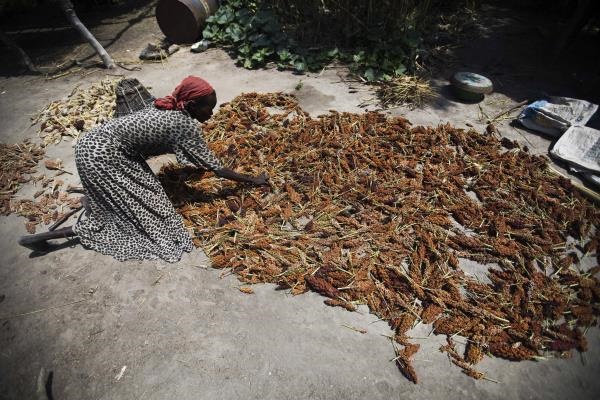
5 April 2016, Juba - Civil strife and unfavourable rains have further reduced crop production in South Sudan, contributing to a cereal deficit of 381,000 tonnes --53 percent greater than in 2015 --and aggravating the already severe food shortages, two UN agencies warned today.
Cereal prices have shot up nearly five-fold since early last year, making it increasingly difficult for people to get enough to eat, according to a new joint Crop and Food Security Assessment Mission report by the Food and Agriculture Organization of the United Nations (FAO) and the World Food Programme (WFP).
The crisis in South Sudan is marked by alarming levels of hunger. Some 5.8 million people, or nearly half of the country's population, are unsure where their next meal will come from, while the rate of severe food insecurity has now reached 12 percent, double the rate of one year ago.
"South Sudan is facing a deadly blend of conflict, economic hardship and poor rains. Together, they are worsening a hunger gap that we fear will force more people to go hungry and increase malnutrition," said WFP Country Director Joyce Luma. "This report makes it clear that improving the food situation requires a peaceful resolution to the conflict."
"Food insecurity has spread to areas previously considered relatively stable, highlighting the cumulative impact of conflict, economic downturn and climactic shocks," said Serge Tissot, FAO Representative in South Sudan.
Localised production failure, markets paralyzed by crisis
South Sudan's cereal shortfall is mainly the result of unfavourable rains in parts of the Bahr el-Ghazal and Equatoria states and disruptions to cropping activities caused by worsening insecurity.
South Sudanese families are forced to cope with soaring cereal prices, which are driven by a combination of the sharp devaluation of the local currency and higher transport costs.
Links between cereal-producing areas - mostly in the Equatoria and Bahr el-Ghazal states - and main markets have become extremely difficult due to heightened insecurity, a proliferation of roadblocks and exorbitant ad hoc taxes levied on commercial transporters along major trade routes.
"Despite huge potential for agricultural production - more than 90 percent of South Sudan's land is arable - just 4.5 percent of available land was under cultivation when the country gained independence in 2011. Now, after over two years of civil war, this percentage has significantly decreased due to widespread insecurity, damage to agricultural assets and limitations in traditional farming methods," said Tissot.
"Yet crop production is possible in the stable areas within conflict-affected states, and is more important than ever. Communities cannot rely on markets or aid deliveries for food, and therefore need to produce on their own," he added. "FAO is working with farmers, fishers and herders, providing them with emergency livelihood kits, seeds, tools, animal health support and training."
Bridging the food gap
The report makes a series of recommendations for immediate action to address hunger, strengthen domestic food production and reduce the food gap in 2016 and into next year.
Most urgent is the need for an immediate improvement of security across the country. In addition, agencies like WFP, FAO and partner organizations need sustained access and resources to provide targeted food and livelihood assistance to the very vulnerable households in areas with the highest levels of food insecurity, especially in parts of Greater Upper Nile and Eastern Equatoria. Where appropriate, provision of livelihoods assistance - such as seeds or tools - that allow communities to produce their own food is required to withstand market disruptions. Improving people's access to micronutrient- and protein-rich food could be achieved through the distribution of fishing kits and use of nutrition vouchers to be traded for locally sourced vegetables, fish and milk.
Other recommendations include: supporting the 2016 cropping season across all of South Sudan by ensuring access to agricultural and fisheries inputs; strengthening farmer and pastoral field schools; expanding veterinary campaigns aimed at keeping people's livestock healthy; and, in conflict-affected areas, assisting in re-establishing livelihoods whenever possible by helping in land preparation and access to inputs.
In 2016, FAO and WFP, together with their partners, will support efforts that aim to increase food availability, strengthen livelihoods and build resilience.
Under the 2016 Humanitarian Appeal, FAO appealed for $45 million to assist 2.8 million people with seeds, tools and other inputs to produce food and keep their livestock healthy, and strengthen the Government's efforts to boost food security. The current funding gap is 16.1 million to meet this goal.
WFP plans to provide food assistance and specialized nutrition support for about 3 million people in South Sudan in 2016, but has a funding gap of $241 million for the next six months.
# # #
About FAO
FAO leads international efforts to defeat hunger. It helps countries to modernize and improve agriculture, forestry and fisheries practices and ensure good nutrition for all. FAO focuses special attention on developing rural areas, home to 70 percent of the world's poor and hungry people. For more information visit: www.fao.org or follow FAO on Twitter @FAOnews @FAOSouthSudan
About WFP
WFP is the world's largest humanitarian agency fighting hunger worldwide, delivering food assistance in emergencies and working with communities to improve nutrition and build resilience. Each year, WFP assists some 80 million people in around 80 countries. Follow WFP on Twitter @WFP_Media @WFP_Africa